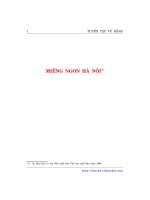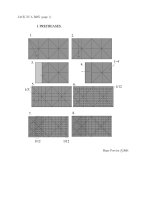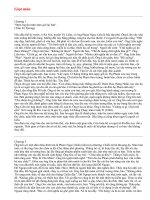Bella Botanica ppt
Bạn đang xem bản rút gọn của tài liệu. Xem và tải ngay bản đầy đủ của tài liệu tại đây (2.82 MB, 5 trang )
Laceweight
Size: 84 x 36 inches
Yarn: Sweet Georgia Merino Silk Lace in
Mist; 1 skein 765 yds., used 730 yds.
Beads: 762 #8 seed beads
Needles: US size 4 circular needle
Notes: Knit Chart 1 six times
Knit Chart 2 three times
Knit Chart 3 one time
Nupps have 7 loops. With fine
laceweight, you could do 9.
Heavy Lace/Light Fingering
Size: 76 x 37 inches
Yarn: Sweet Georgia SeaSilk Lace in
Pistachio; 1 skein 700 yds., used 615 yds.
Needles: US size 5 circular needle
Notes: Knit Chart 1 four times
Knit Chart 2 two times
Knit Chart 3 one time
Nupps have 5 loops
Sportweight
Size: 68 x 32 inches
Yarn: Yarn Chef Cider in Dime Store
Lipstick; 1 skein 375 yds.; used 250 yds.
and The Sanguine Gryphon Bugga in
Rough Fungus Beetle; 1 skein 412 yds.;
used 160 yds.
Needles: US size 7 circular needle
Beads: 78 #6 seed beads
Notes: Knit Chart 1 two times
Knit Chart 2 two times
Knit Chart 3 one time
© 2011 Karen Strauss. You are free to sell shawls made with your own hands using this pattern, however, please do not sell or distribute the
pattern. Ravelry name: like2makethings
Bella Botanica is a versatile pattern for all levels of lace knitters. The shawl can be knit
without beads and nupps or you can add just the beads or beads and nupps. Knitted in three
yarn weights and three sizes provides inspiration for your project choice.
Knit from the top down starting with the tiny new leaves, progressing to the mature
leaves and ending with the trumpet flower edging, this shawl will be a beautiful asset to your
collection and a joy to knit.
Laceweight in Sweet
Georgia Merino Silk Lace
Beads and Nupps
On the charts you will see the letter N to
indicate where a nupp can be placed. If
you do not wish to add nupps, you can put
a bead at that position or just knit the
stitch.
On the charts you will see the letter B to
indicate the placement of a bead. If you do
not wish to add beads, then simply ignore
the letter and knit the stitch.
I put the symbols for the beads on the
right side odd numbered rows, but I
personally like to add them on the
following wrong side row. I like the
placement of the bead on the stitch better,
which you can read about in Ravelry on
my Bead Technique Study. http://
www.ravelry.com/projects/like2makethings/
beading-technique-study
I also find it frees up my concentration for
the stitch pattern if I don’t have to think
about the bead placement. This is
especially helpful for future patterns
where you may want to add a bead onto a
decreased stitch sequence. This is a
personal preference, however, and you
should add beads as you feel most
comfortable.
Borders
There is a three stitch border on each side of
the shawl. You can choose to work this in
garter by knitting the first three stitches at the
beginning and ending of every row on the right
and wrong side of the shawl. Or you can slip
the first stitch as if to purl with yarn in front,
move yarn to back, and knit the remaining two
stitches in the right border and then knit the
three stitches on the left border.
Repeat for the wrong side row slipping the first
stitch as if to purl as you previously did on the
right side row. By slipping the stitch, you
create a little chain effect up the sides of the
shawl that is quite pretty.
Heavy Lace/ Light Fingering
in Sweet Georgia SeaSilk
Lace
Sportweight in Yarn Chef
Cider and The Sanguine
Gryphon Bugga
© 2011 Karen Strauss. You are free to sell shawls made with your
own hands using this pattern, however, please do not sell or
distribute the pattern. Ravelry name: like2makethings
The green shawl was the first one that I made. After
suggestions from Sandra Alice Oakeshott, (Ravelry
name: sandralice), the center spine area and the last
row of edging were improved. A special thank you to
Sandra for her help with this pattern and all the other
projects we have collaborated on.
Gauge
Gauge is not important with this shawl. I knit
loosely and with garments usually go down one
or two needle sizes. However, with shawls, I
knit laceweight with an US 4 and fingering
with an US 5 or 6.
Casting On
You will start at the top center neck edge with
a cast on. This can be a simple cast on of 9
stitches, knit 3 rows and then start Row 1 of
the Set Up Chart or you can do a garter tab
cast on by casting on 3 stitches with a
backward loop, knit 7 rows. Rotate the piece
clockwise and you will see 3 garter bumps on
the edge. Pick up and knit those 3 bumps .
Rotate again and pick up the original 3 cast on
stitches resulting in a total of 9 stitches. Turn.
Knit 3, purl 3, knit 3, turn and proceed to
Setup Chart.
The garter tab cast on blends better with the
border stitches than the simple cast on.
Here is a nice tutorial on the Garter Tab Cast
On: />tab-cast-on/
Instructions
You can customize the size of your shawl by
how many times you repeat Charts 1 and 2. I
have made shawls with various number of
repeats but you can create your own unique
size by your choice of repeats.
Charts show the right side half the shawl.
Read chart right to left. When you have knitted
the center stitch, go back to start of chart row
(minus the three border stitches ) for the left
side of the shawl. Add the 3 border stitches at
the end of each row.
All wrong side rows are K3, purl to last 3
stitches, k3.
Pattern repeats are indicated by yellow shaded
areas surrounded by a red outline.
Set Up Chart
I remember when I was first learning
how to read charts, I found it helpful to
have the pattern written out to double
check that I was reading the chart
correctly. Here are the step by step
directions for the Set Up Chart with
the center stitch indicated with red.
Row 1: Knit 3, *yo, k1, yo, k1, yo, k1,
yo, k3.
Row 2 and all even rows: Knit 3, purl
to last 3 stitches, k3.
Row 3: K3, yo, k3, yo, k1, yo, k3, yo, k3.
Row 5: K3, yo, k5, yo, k1, yo, k5, yo, k3.
Row 7: K3, *yo, k1, k2tog, yo, k1, yo,
ssk, k1, yo,* k1. Repeat * to last 3
stitches, k3
Row 9: K3, *yo, k2, k2tog, yo, k1,yo,
ssk,k2, yo* k1. Repeat* to last 3
stitches, k3
Row 11: K3, *yo, k2, k2tog, yo, k3, yo,
ssk, k2, yo,* k1. Repeat * to last 3
stitches, k3.
Row 13: K3, *yo, k1, k2tog, yo, k1, yo,
ssk, k1, k2tog, yo, k1, yo, ssk, k1, yo *,
k1. Repeat * to last 3 stitches, k3.
Row 15: K3, *yo, k2, k2tog, yo, k1, yo,
ssk, k1, k2tog, yo, k1, yo, ssk, k2, yo *,
k1. Repeat * to last 3 stitches, k3.
Row 17: K3, *yo, k1, yo, sl2k1psso, yo,
k3, yo, sl2k1psso, yo, k3, yo, sl2k1psso,
yo, k1, yo *, k1. Repeat * to last 3
stitches, k3.
After completing the Setup Chart,
move to Chart 1. (Tiny Leaves). You
can repeat this 6 row pattern multiple
times
Next, work Chart 2, (Mature Leaves).
Again this 12 row pattern can also be
repeated multiple times.
Next, work Chart 3, (Trumpet Flower)
only once.
© 2011 Karen Strauss. You are free to sell shawls made with your own hands using this pattern, however, please do not sell or distribute the
pattern. Ravelry name: like2makethings
j j v j j v j j v j j
17
45
j \ j j | \ j j | j
15
41
j \ j j | \ j j | j
13
37
j \ j j | j
11
33
j \ j j | j
9
29
j \ j j | j
7
25
j j
5
21
j j
3
17
j j
1
13
Green boxes indicate total stitch count for the row.
Blue boxes indicate row numbers
Set up Chart
Border
Stitches
Center
Stitch
© 2011 Karen Strauss. You are free to sell shawls made with your own hands using this pattern, however, please do not sell or distribute the
pattern. Ravelry name: like2makethings
Stitch Key
j
|
\
v
N
B
No Stitch
Knit
Yarnover
Knit 2 together
SSK
Slip 2 tog as if to knit , K1,
pass slipped stitches over
Optional nupp
Optional bead
Finishing
Cast off using a stretchy cast off. I like
this one: knit 2 stitches, slip 2 stitches
back on the left needle and knit tog
through the back loops. *Knit 1 , slip 2
stitches back on the left needle and knit
tog through the back loops, repeat *until
all stitches are bound off. You can use
this bind off on the right side or the
wrong side of your shawl. If you yarn is
fine lace weight, you might want to
consider doubling the yarn for the bind
off. Weave in loose ends but leave a
small amount of yarn tail as the yarn
may be drawn up in the blocking process.
After blocking, trim off any loose ends.
j \ j j | j | j v j \ j \ j j | j | j v j \ j \ j j | j | j v j \ j \ j j | j
53
j j | j | \ j \ j j | j | \ j \ j j | j | \ j \ j j
51
j j | j | \ j \ j j | j | \ j \ j j | j | \ j \ j j
49
j j |
B
\ j j |
B
\ j j |
B
\ j j
47
j
B B
\ j j |
B B
\ j j |
B B
j
45
j
N
\ j j |
N
\ j j |
N
j
43
j \ j j | j | j v j \ j \ j j | j | j v j \ j \ j j | j
41
j j | j | \ j \ j j | j | \ j \ j j
39
j j | j | \ j \ j j | j | \ j \ j j
37
j j |
B
\ j \ j j | j |
B
\ j j
35
j
B B
\ j j |
B B
j
33
j
N
\ j j |
N
j
31
j j v j j v j j v j j v j j v j j v j j v j j v j j v j j v j j v j j v j j v j j
85
j \ j
B
j | \ j
B
j | \ j
B
j | \ j
B
j | j
83
j \ j
B B
j | \ j
B B
j | \ j
B B
j | \ j
B B
j | j
81
j \ j j | \ j j | \ j j | \ j j | j
79
j \ j
B
j | \ j
B
j | \ j
B
j | \ j
B
j | j
77
j
B
| j j \
B
| j j \
B
| j j \
B
j
75
j
B
| j j \
B
| j j \
B
| j j \
B
j
73
j
B
| j j \
B
| j j \
B
| j j \
B
j
71
j
B
| j j \
B
| j j \
B
| j j \
B
j
69
j
B
| j j \
B
| j j \
B
| j j \
B
j
67
j
B
| j j \
B
| j j \
B
| j j \
B
j
65
j j v j j v j j v j j
63
j j | \ j j | \ j j | \ j j
61
j j |
B
\ j j |
B
\ j j |
B
\ j j
59
j
B B
\ j j |
B B
\ j j |
B B
j
57
j
N
\ j j |
N
\ j j |
N
j
55
Green boxes indicate total stitch count for the row. The number above indicate number of repeats of the 6 row pattern.
Blue boxes indicate row numbers
j j v j j v j j v j j v j j v j j
29 69 93 117 141 165
j \ j j | \ j j | \ j j | \ j j | j
27 65 89 113 137 161
j \ j j | \ j j | \ j j | \ j j | j
25 61 85 109 133 157
j \ j j v j j v j j | j
23 57 81 105 129 153
j \ j j | \ j j | \ j j | j
21 53 77 101 125 149
j \ j j | \ j j | \ j j | j
19 49 73 97 121 145
Center
Stitch
Border
Stitches
Border
Stitches
Border
Stitches
Center
Stitch
Center
Stitch
Chart 1
Chart 2
Chart 3
© 2011 Karen Strauss Ravelry name: like2makethings
1x 2x 3x 4x 5x









